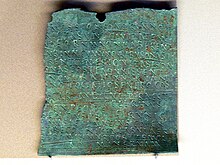Cohors II Aquitanorum
The Cohors II Aquitanorum [civium Romanorum] [equitata] ( German 2nd cohort of the Aquitanians [of the Roman citizens] [partly mounted] ) was a Roman auxiliary unit . It is evidenced by military diplomas , inscriptions and brick stamps. In the inscription ( CIL 13, 6812 ) it is referred to as Cohors II Biturigum .
Name components
- Aquitanorum : the Aquitaine . When the unit was set up, the soldiers of the cohort were recruited from the various Aquitaine tribes in the Roman province of Gallia Aquitania .
- Biturigum : the Biturigen .
- civium Romanorum : the Roman citizen. The soldiers of the unit had been granted Roman citizenship at one point in time. However, this did not apply to soldiers who were accepted into the unit after this point in time. They received Roman citizenship only with their honorable farewell ( Honesta missio ) after 25 years of service. The addition occurs in military diplomas from 116 to 167/168.
- equitata : partially mounted. The unit was a mixed association of infantry and cavalry.
Since there is no evidence of the addition of milliaria (1000 men) to the name , the unit was a Cohors (quingenaria) equitata . The nominal strength of the cohort was 600 men (480 infantry and 120 horsemen), consisting of 6 centuries of infantry with 80 men each and 4 tower cavalry with 30 horsemen each.
history
The cohort was stationed in the provinces of Germania , Germania superior, and Raetia (in that order). It is listed on military diplomas for the years AD 82 to 167/168.
The first evidence of unity in Germania is based on a diploma dated 82. In the diploma, the cohort is listed as part of the troops (see Roman Armed Forces in Germania ) that were stationed in the province. Further diplomas, which are dated to 90, prove the unity in Germania superior .
At an unspecified point in time, the cohort was moved to Raetia. The first evidence of provincial unity is based on a military diploma dated 114/200. In the diploma, the cohort is listed as part of the troops (see Roman Armed Forces in Raetia ) that were stationed in the province. Further diplomas, dated 116 to 167/168, prove unity in the same province.
Locations
Locations of the cohort in Germania were possibly:
- Arnsburg Castle ( Lich )
The locations of the cohort in Raetia were:
- Fort Kumpfmühl ( Regensburg-Kumpfmühl ): The unit was stationed here from around 120 until the fort was destroyed in the Marcomann Wars. Then she built the Dambach fort.
- Fort Dambach : The unit was stationed here until the Limes Falls around 254.
Bricks with the stamp of the unit were found in Arnsburg and Regensburg .
Members of the cohort
The following members of the cohort are known.
Commanders
|
Others
|
See also
Web links
Remarks
- ↑ Both John Spaul and Farkas István Gergő assume that the Cohors II Biturigum is identical to the Cohors II Aquitanorum , in analogy to the Cohors I Aquitanorum Biturigum .
- ↑ According to Farkas István Gergő, there were three cohorts in Raetia that had the addition of civium Romanorum . Spi [] was therefore either prefect of the Cohors II Aquitanorum , the Cohors I Breucorum or the Cohors III Thracum .
- ↑ a b c d e The inscription was found near Regensburg, where, according to Farkas István Gergő, the Cohors II Aquitanorum , the Cohors III Britannorum and the Legio III Italica were stationed. An exact assignment of the listed soldier to one of these units is not possible because the name of the unit is missing in the inscription.
Individual evidence
- ^ A b John Spaul: Cohors² The evidence for and a short history of the auxiliary infantry units of the Imperial Roman Army , British Archaeological Reports 2000, BAR International Series (Book 841), ISBN 978-1841710464 , pp. 139-140, 146
- ^ Jörg Scheuerbrandt : Exercitus. Tasks, organization and command structure of Roman armies during the imperial era. Dissertation, Albert-Ludwigs-Universität Freiburg im Breisgau 2003/2004, pp. 159–160, tables 3-4 ( PDF pp. 161–162 ).
- ↑ a b c Farkas István Gergő: The Roman Army in Raetia Dissertation, University of Pécs Faculty of Humanities 2015, pp. 137–138, 244–259, 373–374, 442–460, 464, 468, 481 ( PDF p. 140–141, 247–262, 376–377, 445–463, 467, 471, 484 ( Memento of the original dated December 14, 2016 in the Internet Archive ) Info: The archive link was inserted automatically and has not yet been checked. Please check the original and archive link according to the instructions and then remove this note. ).
- ↑ Military diplomas of the years 82 ( CIL 16, 28 ), 90 ( CIL 16, 36 , RMD 5, 333 , ZPE-148-261 ), 114/200 ( ZPE-178-247 ), 116 ( RMD 3, 155 , RMD 4, 229 ), 121/140 ( RMD 5, 390 ), 125/128 ( RMD 1, 32 ), 128/133 ( AE 2005, 1150 ), 138/140 ( RMD 2, 94 ), 139 ( RMD 5, 386 ), 140 ( RMD 5, 387 ), 151/170 ( RMD 1, 51 ), 154/161 ( CIL 16, 117 , RMD 3, 175 ), 157 ( RMD 3, 170 , RMD 4, 275 , RMM 38 ), 159/160 ( AE 2005, 1153 ), 160 ( RMD 4, 278 ), 161/163 ( RMD 2, 112 ), 162 ( CIL 16, 118 ), 166 ( CIL 16, 121 ) and 167/168 ( RMD 1, 68 ).
- ↑ brick temple Arnsburg ( AE 1903 00093c ), Regensburg ( CIL 3, 6537 , IBR 503 ).

